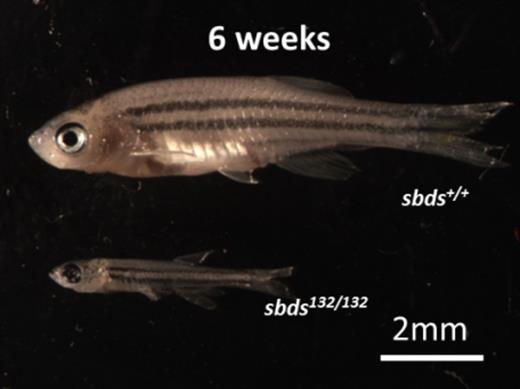Abstract
Shwachman-Diamond syndrome (SDS) is a multisystem disorder characterized by neutropenia, exocrine pancreatic insufficiency, and skeletal abnormalities. Individuals with SDS are also at increased risk for developing myelodysplastic syndrome (MDS) and/or acute myeloid leukemia (AML). SDS results from mutations in the SBDS gene, which encodes a protein involved in 80S ribosome maturation. Genetic ablation of Sbds results in early embryonic lethality (ED 7.5) in mice. Zebrafish provide an attractive model organism with demonstrated relevance to mammalian hematopoiesis. Genome analysis of zebrafish (Danio rerio) revealed the presence of a single sbds gene, encoding a protein 90% identical to the human orthologue. qPCR demonstrated presence of sbds transcript in in all stages of the development including unfertilized egg. We used CRISPR/Cas9 genome editing technique to generate indel mutations in sbds. We established multiple zebrafish lines with mutations in the sbds gene. We have now characterized two alleles: 1) sbdsnu132, a 7-base deletion, that results in a frameshift at the amino acid G63 and a premature stop codon and 2) sbdsnu167, a 21-base insertion, that might encode a defective protein. The introduced indels correspond to the frequently mutated site, K62X, in SDS. Western blotting during the first days post fertilization (dpf) in sbdsnu132/nu132 mutants showed a decrease of Sbds with time, until 8 dpf when the protein was absent. These results suggest that the presence of Sbds during early stages of the development is due to maternal deposition. Loss of Sbds activity results in reduced viability. Unlike Sbds-/- mice, homozygous mutant sbdsnu132 live up to 6 weeks, but display a marked growth retardation phenotype (Figure 1). Interestingly, growth retardation was not observed until 15 dpf. Unlike morpholino-mediated knockdown of sbds, as reported by Provost et al., Development, 2012, pancreatic development appeared normal as determined by fluorescence microscopy using the transgenic line Tg(ptf1a:eGFP)jh1. To determine whether loss of sbds affects the number of neutrophils and macrophages, we used the transgenic lines Tg(mpx:Dendra)uwm4 and Tg(mpeg:Dendra)uwm12. We observed a significantly lower number of neutrophils in sbdsnu132/nu132 mutants compared to the wild-type fish at 5 and 15 dpf (p<0.05 and p<0.01 by t-test, respectively). However, no statistically significant difference in macrophage number was found. To our knowledge, we established, the first zebrafish model of SDS, making it a highly relevant model to understand its pathophysiology. Comparison of null states between mice and zebrafish suggest that loss of sbds results in two phenotypes: an early embryonic stage required for viability and development and a post-embryonic (larval) stage critical for granulocyte production and normal size. Ongoing studies are evaluating bone formation, pancreatic acinar function, and ectopic expression of patient-derived SBDS mutations in the context of a null background. Their phenotypes will be presented. (This work was supported by grants from the NIH and the Alex Turnquist Memorial Research fund of Shwachman-Diamond America).
Corey:Jazz Pharmaceuticals: Speakers Bureau.
Author notes
Asterisk with author names denotes non-ASH members.


This feature is available to Subscribers Only
Sign In or Create an Account Close Modal